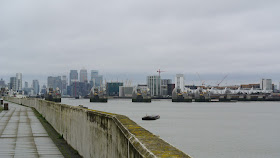Woolwich has a long history with evidence of an iron age settlement near the current ferry terminal. Our plan of the day was to walk and not search out the settlement and so we set off along the riverside path from our starting point to the Woolwich foot tunnel. As we walked I watched the Woolwich ferry.
A ferry has probably existed here since the late 12th century. A toll used to be charged until 1889 when the people of Woolwich campaigned for it to be free. The charges were dropped and the ferry has been free to use since then. I must travel across on the ferry at some point in the future.
We very quickly came to the entrance to the foot tunnel.
The tunnel was opened in 1912 and is open 24 hours a day all year. The tunnel is 550 yards long and there are 126 steps down into it and 101 up on the other side. We all walked down but John took the lift up on the other side. Lucy and I walked up counting the steps as we went.
Here we are under the Thames.
In 1512 Woolwich Naval Dockyard was a major establishment in the area and as we walked we passed a lot of evidence of the dockyard. Looking away from London this was the view.
Turning to face the direction we were walking this was the view.
The tide was out and there were a lot of gulls and ducks on the foreshore. A little further along the promenade we came across this battered mosaic. It was installed in 1984 by the National Elfrieda Rathbone Society which helps people whose needs have not been met by education.
We passed a pair of disused cannon. I couldn't get them both in the photo.
We also passed another mosaic , this time a nearly complete one.
On the opposite bank we saw the Tate and Lyle sugar refinery in Silvertown.
We got quite close to the Thames barrier before we turned away from the Thames. Any area near a river is liable to flood and the Thames is at huge risk due to the large amount of extra tidal water at certain times. In 1953 300 people were drowned in a disastrous flood. To prevent this happening again the Thames Flood Barrier was completed in 1984. The gates normally rest on the river bed and can be raised by electro-hydraulic power into the upright position between the piers that you can see in the picture. It takes 45 minutes for full closure to be achieved.
On our left we spotted the clockhouse of 1784. This was once the house and also the office of the Admiral-Superintendent of the Dockyard. It is now a community centre.
We left the river and headed to Maryon Park and Maryon Wilson Park. We stopped and ate our sandwiches in Maryon Wilson Park looking down towards the children's zoo where I saw this handsome duck, a visitor from europe.
Through the parks the walk was easy going and we made good time until we reached Eltham Common from where we headed up a steep path into a belt of ancient woodland with Castlewood, Jackwood and Oxleas Wood. Once at the top we came upon Sevendroog Castle. The name of the triangular building comes from a fortress in India that was captured by Commodore Sir Williams James. During the 18th century he owned this land. Following his death in 1784 his widow built the tower as a memorial. The best bit was it housed a cafe and the coffee and cake was delicious.
Refreshed we continued through gardens and woodland. At times it was very muddy.
When we reached Falconwood we decided to carry on to Grove Park. This brick structure is a Conduit Head. This building once housed sluices that controlled the flow of water from springs to Eltham Palace.
Just around the corner we came across this delightful church, Holy Trinity Church consecrated in 1869. It has a chapel, the Gallipoli Chapel which is a memorial to those who died in the World War 1 battle of Gallipoli.
From here we eventually reached the gates of Eltham Palace. I couldn't get a good photo due to the trees.
Here's the bridge to take visitors over the moat.
Eltham Palace was the principal country residence of the English monarchy for nearly 250 years from the early 14th century to the mid 16th century. Across the road from the palace was this cute timber framed building that dates from the 16th century which was the Lord Chancellor's lodging with Cardinal Wolsey and Sir Thomas More being residents at times.
Although the photo suggests it was taken earlier in the day it was actually taken as it was getting dark so for the remainder of this walk we upped the pace to make it back to the station before it was fully dark.
It was a great day out and we completed the two sections covering 9.7 miles. With the walking we did to and from the station at both ends of the day by the time I got home I had walked 14.5 miles. A rest before cooking dinner followed by a hot bath to give the aching muscles a soak and then early to bed. We have two more sections to do and we will have completed the walk. Now we can think about what we are going to do to celebrate and which walks to tackle later in the year.
Lyndsey



















Thank you for a most interesting post. I do love the photos and explanations of the areas you visit. Was a great read with my early morning coffee.
ReplyDeleteI so enjoy your walks! Thank you so much for sharing them.
ReplyDelete